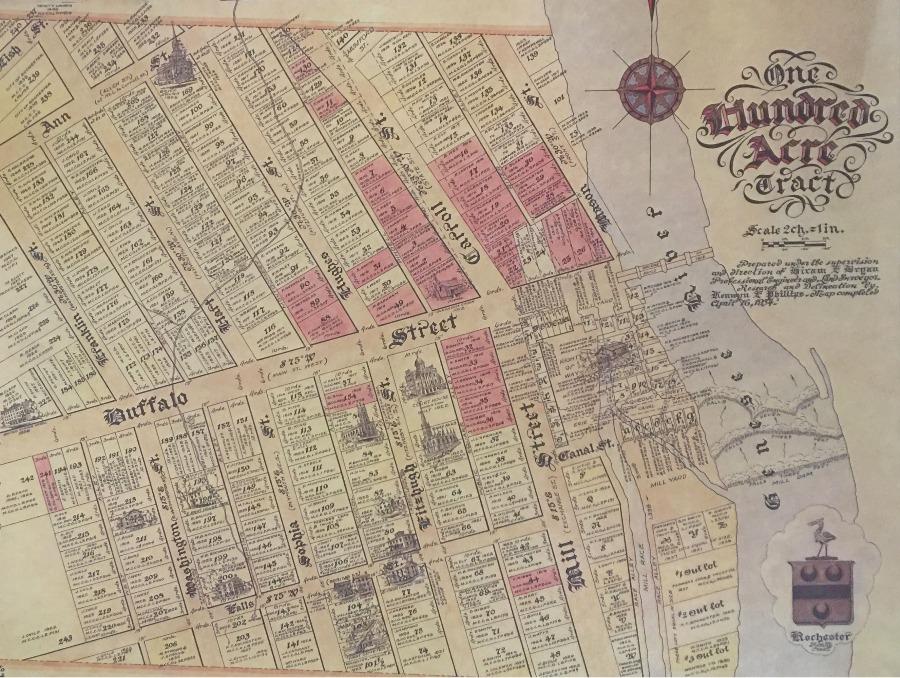Nathaniel Rochester, William Fitzhugh and Charles Carroll, the trio who famously purchased the One Hundred Acre Tract of land that grew into the city of Rochester, were Southerners from Hagerstown, Maryland. As such they were an anomaly. For the most part, the earliest settlers in Western New York came from New England, bringing with them a Puritan ethic that infused their work as well as their worship. Perhaps no one embodied that spirit more than Josiah Bissell Jr. whose life was short, but his accomplishments long.
Born in 1790, he grew up in Pittsfield, Massachusetts and by his late teens was working with his merchant father in an establishment known as Bissell & Son. Josiah had two friends from Springfield, the brothers Elisha and Hervey Ely, who were drawn to “Rochesterville” shortly after lots went on sale within the 100-Acre Tract. By 1813, the Elys and Josiah Bissell, were partners in the Red Mill, the first commercial structure built within the new settlement. An early city historian reported on its success: “[F]or years, the mill continued to grind the ‘grists’ that crowded to its doors from far and near.”
Bissell pursued many other interests, often so righteously religious that some Rochesterians found him annoying. He launched a campaign to put a Bible in every home. He founded a six-day transportation company that delivered people, mail and goods without desecrating the Sabbath, which other less fervent companies did regularly.
One Sunday when a group of Presbyterians found themselves squeezed uncomfortably into a small schoolhouse for their religious service, they expressed the need to find a new location. Bissell announced he would build a church by the following Sunday, a boast that parishioners found quite arrogant. Years later, the congregation’s pastor, Rev. Dr. Joel Parker, recalled how Bissell “contracted for timber with one set of men, framing it with another, seats at one carpenter’s shop, glazing doors at another, pulpit &c. at another, and employed two gangs of men to lay floors. By Tuesday night the framing was begun, Thursday it was boarded in, Friday floors laid, Saturday pulpit and seats put in place….” The next day, 400 people worshipped at the new church.
In the fall of 1830, Bissell invited Presbyterian minister Charles G. Finney to speak. Today Rev. Finney is remembered as the Father of Modern Revivalism and it was in our city where he probably earned the title, giving 98 sermons over a six-month period. His passionate (some might say fanatic) sermons attracted huge crowds. Local shopkeepers closed their businesses when he spoke, posting notices that urged their customers to attend Finney’s rallies.

In February 1831, as Finney neared the end of his days in Rochester, Josiah Bissell fell dangerously ill. With the arrival of spring, he seemed sufficiently recovered and set off for Seneca Falls to oversee construction of a mill. The next day he showed signs of severe fatigue and, by evening, began coughing blood. Urged not to speak out of concern he would further irritate diseased lungs, he communicated with signs or by writing on a slate.
When it became apparent that he was dying, he used his voice one final time. Attendants overheard him reciting Psalm 42: “Why art thou cast down, O my soul, and why art thou disquieted within me? Hope thou in God; for I shall yet praise him, who is the health of my countenance and my God.” On Tuesday, April 5, 1831, Josiah Bissell Jr. died at the age of 40 years. However controversial he had been in life, no one could deny his many accomplishments and he was profoundly mourned in death.
Today, his son Josiah W. Bissell is perhaps better remembered for contributions he made to our city, most notably as the man who named East Avenue. But the father left an important legacy for our Third Ward neighborhood. While living on Troup Street, he speculated in land near his home. That property shows up in an early plat book as the Cornhill Tract. In 1970, a group of artists adopted the name for an art show they were planning. The name resonated so well that today the old Third Ward is known as Corn Hill and that art show, of course, became the Corn Hill Arts Festival.
